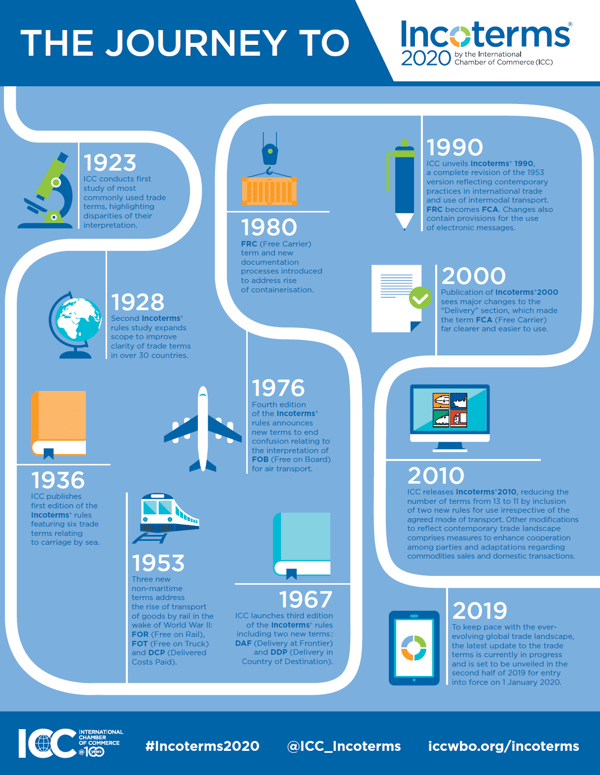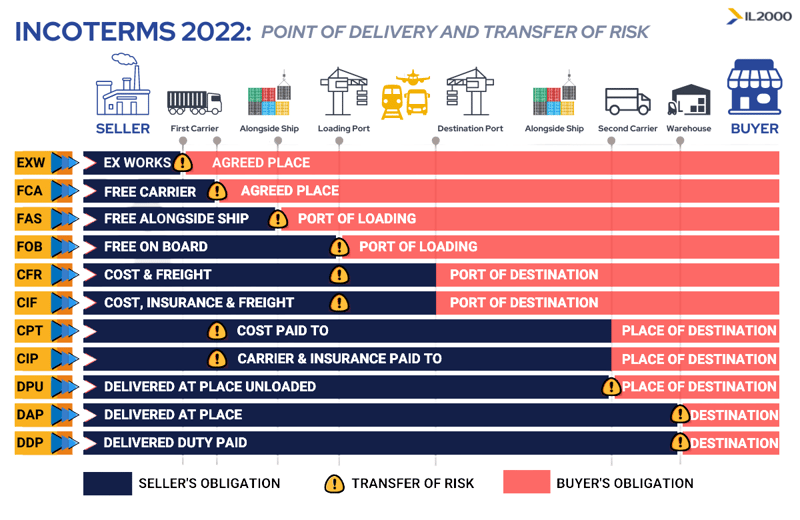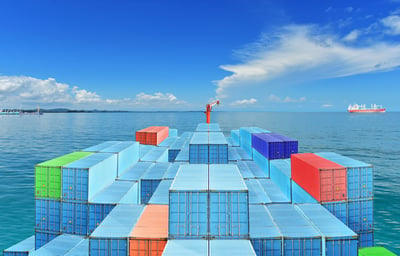In the early 1800s, the world was starting to see its first real glimmer of a structured, regulated international economy. Fueled by the British Empire’s mercantile expansion across the globe, a network of maritime shipping lanes now crisscrossed the oceans. Global commerce had arrived, and a tailor in Bristol could import fabric from a textile manufacturer in New Delhi who had in turn sourced bales of raw cotton from Dhaka in Bangladesh.
But with great opportunity came great complexity. Governments and merchants began to ask difficult questions about how to make international commerce more consistent and reliable. At the heart of that conversation beat two crucial questions that’d shape the tradescape for the next 200 years:
- Who should be responsible for the cost of transport?
- Should the buyer or seller shoulder the risk?
Starting with these two deceptively simple questions, in this blog, we’ll introduce you to Incoterms. We’ll show you where they came from, what they look like today, and how your strategies for using these clunkily named shipping protocols can have a profound impact on your profitability if you import or export as part of your supply chain.
Then we’ll explain how IL2000 can simplify all of it for you with a comprehensive range of international shipping services, including shipment booking, tracking, preparation of documents, customs clearance, routing and compliance advice. Think of us as a travel agent for your cargo.
To get the ball rolling, let’s briefly turn back to the early 1800s.
The birth of INCOTERMS
In 1812, the British Government began a push to enshrine a set of international commercial terms into import and export transactions between residents of different countries. The first of these was named Free on Board (FOB), a term importers and exporters still use today. This approach dictated that the seller was responsible for clearing its goods for export, ensuring safe delivery onto a transport vessel at the port of departure. From that point onward, it was the buyer who assumed responsibility both for transport cost and risk.
Of course, merchants were free to negotiate alternate shipping arrangements, but FOB established a crisply unambiguous “default position.” In one elegantly administrative flourish, trading across the seven seas became that little bit easier.
And the rest, in its temporally tempestuous way, was history: In 1895, a new term was introduced to give importers and exporters different insurance options, and a small but efficient assortment of alternative modalities soon followed in its wake.
In 1919, the International Chamber of Commerce (ICC) took the lead, swiftly codifying the new modes of international trade and publishing a tome that has been successfully lulling supply chain managers to sleep ever since: The International Rules for the Interpretation of Trade Terms, shortened — thank the logistics gods — to Incoterms.
The complete history of Incoterms is fascinating, doubly so if you’re a card-carrying logistics nerd (guilty as charged). But you have a business to run, so to cut a long story short, the Incoterms rulebook has steadily evolved across the decades, keeping pace with new modes of transport, new forms of finance, and new ways of doing business.

Incoterms 2020 is the International Chamber of Commerce’s current iteration, bringing structure and guidance to trillions of dollars worth of international trade transactions every year. IL2000’s glossary is a good starting point to dive into the fine detail of Incoterms 2020. In there, you’ll find a complete description of each mode.
Incoterms here and now
Here’s what Incoterms look like today. As you can see from the chart, we’re dealing with a far more complicated playbook with 11 modalities available. However, when you break the chart down to its fundamentals, it’s still answering exactly the same kinds of questions merchants and governments were asking at the dawn of modern international economy: who’s responsible for payment, who’s responsible for risk?
Oh, and check out mode 4. The Free on Board modality is still ticking along like clockwork after over two centuries of international commerce.
So let’s take a closer look at this chart. Notice something a bit unusual?
- Across the top, you’ll encounter a colorful progression of tangibles — from a brick and mortar seller’s manufacturing facility through an array of transportation infrastructure and ending at the buyer’s warehouse. These are all things. They’re points in a physical journey. All good so far.
- Scan your eye down and you’ve got those colorful blue and red bars representing the seller’s and buyer’s obligations. Here things can get a bit fuzzier if you’re new to this. It’s fairly intuitive that something important happens when obligation flicks like a switch from one party to another. But what exactly? One thing’s for sure: Whatever happens, it’s not as physical and obvious as “warehouse,” “truck,” or “port.”
- Then you have those unsettling little exclamation points. The moment at which “risk” transfers from seller to buyer might sound abstract. Without skin in the game, you could be forgiven for assuming the infographic’s little exclamation points are the logistics equivalent of Disneyland warning you to keep your arms inside the vehicle on the “It’s a Small World” ride. What just happened? How did we get from the firm reality of “truck” to here, an abstract realm where risk changes hands with a seemingly mystical exclamation point?
And there’s the rub. Incoterms are a weird blend of physical infrastructure and the intangible infrastructure of trust. Both, in their own way, have to be strong enough to cross oceans. Both are equally important.
We’ve worked with many clients to unravel their Incoterms challenges. Here’s one great example. We’ve found the first mistake most international shippers make is one of simple, garden variety complacency. They’re looking at the physical path from seller to buyer and not worrying enough about who’s responsible for what.
Six steps to avoiding the Incoterms pitfalls
We’ll begin here with a disclaimer. Using Incoterms correctly takes years of learning and experience. The ICC’s rigorous training and accreditation processes aren’t window dressing. If staying on top of Incoterms is not a part of your everyday job, you’re not going to know all of this back to front.
Before you decide to tackle Incoterms yourself then, consider the advantage of working with IL2000. Our team has decades of experience in international shipping. We take ownership of the difficult decisions that can make or break an international freight operation.
Here’s where you can start that conversation.
To begin building a basic proficiency, start with these six ground rules.
1. Recognize that buyers and sellers don’t have the same interests
Company X manages its own international shipping. They negotiate a purchase with a seller in China. Company X requests that the product delivery costs be the seller’s responsibility until it hits the US port. The seller agrees. Six weeks later, the shipment arrives in LA. Company X is based in Michigan.
OK, you both want the sale itself to happen. The buyer wants the product, the seller wants the money. But you’ll typically have conflicting interests in the terms governing how the shipment happens. In the above example, the seller had the option to shed responsibility and risk at the nearest compliant port. They did exactly that. Why wouldn’t they? The ensuing headache of getting the shipment to its destination fell to Company X to solve.
2. Understand that responsibility rests with you (or your 3PL!)
Company Y works through IL2000 (yes, this is a real example). They request that we manage a shipment from a supplier in Japan. We note that Company Y’s costing assumes all shipping costs (the mode known as Ex works, or EXW), but discover the supplier signed off on FOB. That means the supplier is responsible for all origin costs. We end up saving our client a couple of thousand dollars per shipment.
No regulations force your company to learn the rules of engagement. No law forces companies you’re dealing with to disclose that you’re paying more than you should. The responsibility to know your entitlements rests solely with you … or your 3PL if you’ve chosen that route.
3. Appreciate that shipping strategies are dynamic and volatile
You purchase a regular shipment from Company Z, in France. This is a purchase you’ve made a dozen times before so you push the paperwork through quickly and efficiently. Then accounting discovers your invoice now includes a hefty additional shipping charge.
Pre-Covid, companies might set up their shipping terms and leave them alone for a year or more. Companies could buy repeatedly from suppliers expecting a healthy level of consistency. In 2022, pricing strategies have shifted drastically. Company Z may well shift to a different and more favorable Incoterm with each new shipment. You have to have your wits about you in this dynamic and volatile shipping environment.
4. Build a clear physical understanding of your supply chain
Meanwhile, our friends at Company X have learned a thing or three about Incoterms and contacted the same supplier in Japan to deliver a shipment to their nearest port in Wisconsin. This time the shipment arrives where expected, but it’s damaged. Company X discovers they’re liable. The supplier’s risk ended when the shipment was transferred from one vessel to another in … you guessed it … LA.
The point at which risk transfers from buyer to seller can be extremely precise — right down to the vessel it was on when the damage took place. It’s crucial that you understand exactly how Incoterms impact every physical leg of your journey. Simply having a grasp on how it all works in theory won’t cut it.
5. Take binding decisions seriously
Company Y (an IL2000 partner) is negotiating the purchase of a big shipment, this time from Spain. We sit down with them to look over the paperwork and see that the seller is proposing a FOB shipment. We offer an alternative approach that meets the seller’s needs while delivering a far more favorable result for our client. The shipment goes off without a hitch and Company Y ends up realizing an additional $10,000 per year in freight savings.
If Company Y had gone ahead with the sale before talking to us first, their hands would have been tied. They might just have ended up wearing more risk; on the other hand, they may have found themselves thousands of dollars needlessly out of pocket.
By talking to IL2000 while the deal was still on the table, we were able to build crucial terms negotiations into their contract. Take binding decisions seriously, and bring experts into your negotiations as early as possible.
All six of these rules really come back to avoiding complacency.
It’s important to remember that enormous international transactions have gone south on the terms guiding a shipment. Businesses have won unexpected boons or paid the ultimate price thanks solely to the three-letter acronym a supply chain manager chose to checkmark on a commercial invoice.
If you don’t know exactly what that term means — from how it’s structured and administered right down to the vessel or dock where your responsibility and risk begins — talk to IL2000.
Got 99 problems but Incoterms ain’t one

As an expertise-driven 3PL, IL2000 won’t just make sure you choose the right Incoterm for your next international shipment. We’ll explain why, fast-tracking your logistics team’s international shipping know-how with years of knowledge and experience.
Take the stress and risk of international shipping off the table.

